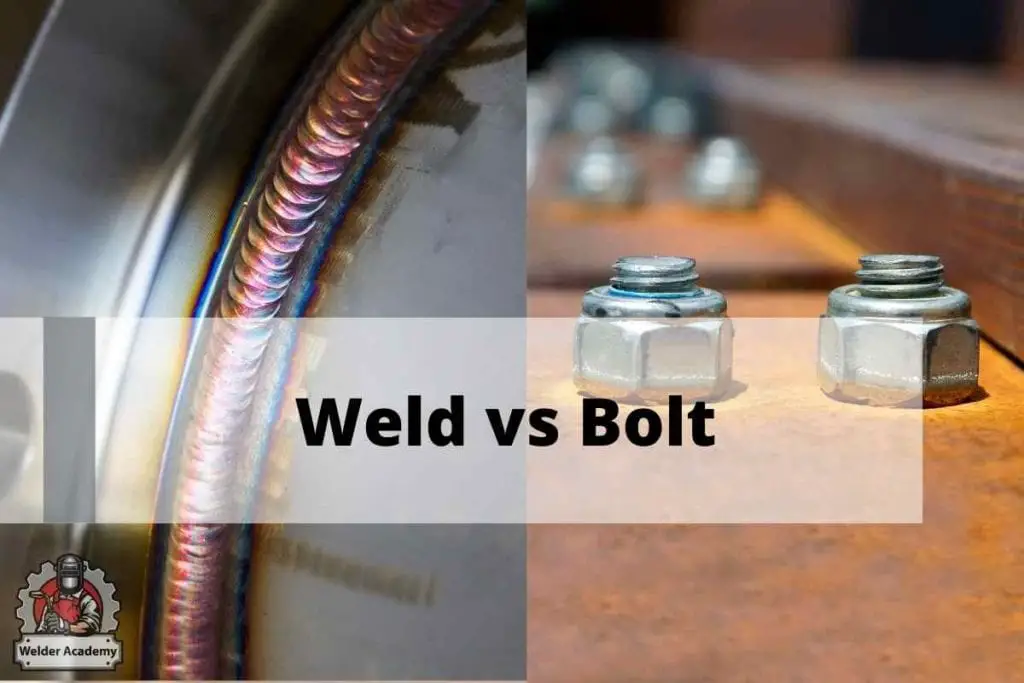Whether you’re building a personal project or a giant design, it’s normal to have a dilemma when it comes to choosing between bolt vs weld. An important decision like this requires attention because it can change the quality and stability of your construction.
If you are looking for versatility, then go for bolts. It can be easily repaired and is relatively inexpensive too. However, if you want an elegant design that is less expensive, welds are a good option. Welds are also recommended for better structural integrity.

There are several factors to consider when choosing one method over the other. So let’s dive deep into the fundamentals of bolts and welds to understand which suits you.
Bolts vs Welds
Bolting is the mechanism of fastening more than one part in a construction joint via screw threads. It is the most basic element of design and manufacturing.
On the other hand, welding is the act of fusing metal components together by soldering and brazing. It is by far the most effective and durable method of joining two metals.
Common differences in Bolt and Weld methods are:
- Bolts don’t require certified professionals to install but welds do
- Bolts provide more flexibility but welds provide more strength
- Bolts are relatively cheaper but welds are expensive
- Bolts can be easily repaired but with welds it’s more complicated
Advantages And Disadvantages Of Bolting
Let’s have a look at some of the advantages and disadvantages of bolting.
Advantages
The greatest advantage of using bolts instead of welds is its versatility. From the wide range of selections, you can find any type of bolt to fit your particular design. It comes in especially handy when you are in a dilemma about whether a part needs to be permanently attached. In those situations, you can simply use bolts to get the purpose served for the time being.
It is fairly easy and uncomplicated to install bolts; there is no mandatory requirement for skill. On the contrary, welding is much more complex and requires the welder to have some skill to execute. The most intricate aspects of fastening bolts can be learned in a short time.
Disadvantages
Bolts indeed come in extremely versatile components suitable for most builds. However, they are also manufactured to be replaced in time. The parts that move are subject to loosening and losing their grip upon usage and time. It needs to be fastened occasionally, or else the structure might lose its support.
Bolt replacements are found easily, but it does not make the entire ordeal feasible. Not only do some bolts have their threads stripped, but sometimes bolts become too seized up to be removed. It is a very common issue for stainless steel structures.
In a few scenarios, bolting is more difficult to carry out in comparison to welding. For instance, if you have to fasten thick-based components for your construction, you would most likely require large bolts. To install the bolts, you would also need additional equipment like drill presses or modern magnetic drills.
Unless you were previously acquainted with these machines, it might even be easier to opt out of welding instead of bolting.
Advantages And Disadvantages Of Welding
The advantages and drawbacks of welding are as follows.
Advantages
Welding is the joining of two pieces of metal together with an additional filler metal. The point of connection is strengthened by soldering and brazing where the filler metal is merged with the base metal. Welding lasts for a long tenure of operation. Its strength is unparalleled in comparison to bolting.
It gives a very elegant and smooth finish to the build. Since it can be done in any shape and direction, the finished product feels natural with a simplistic design.
Disadvantages
Welding cannot be done by laymen. You need professionals with a certain level of skill to carry it out. As important as it is to construction work, welding requires strenuous practice and training to be done properly.
The output of welding is a relatively permanent product. At times, it can become quite problematic for the build. For example, if you need to repair the metal piece, you will have to remove the weld first. This is time-consuming and can potentially damage the base of the material even more.
It is also a very complicated task. You need to be very mindful of what material you are using. Stainless, for instance, is more likely to deform due to heat than other steel. The post-welding condition of the base metal also requires consideration for further use.
A bad welding job can negatively affect the structural integrity of the base material. It is very easy to use a disproportionate amount of filler metal to weld and cause this to happen. To correct this mistake, the welder needs to weld over the previous botched job.
By doing so, the base material is put under excess pressure, which reduces its tenure of productivity. In such cases, it is best to not jeopardize the construction and use bolts to put the joints together.
Price Comparison: Which One Is More Costly?
Although it can’t be said for certain about the prices of the two, bolted joints are generally cheaper. The price of steel components plays a huge role in this regard. Bolts are manufactured using less costly materials. Moreover, their machine-driven production also makes it inexpensive. Installation costs are kept to a bare minimum as well.
Components used in welding joints are expensive. Sometimes installation can be cheap, but experienced and certified welders can cost a lot more for a fine job. Welding equipment and materials can also be expensive to transport.
Ease Of Use And Structural Performance
Welding is easier to carry out in terms of requiring less involvement of external equipment. But you need to understand that welds need to be done by certified professionals. If not, a botched job might be detrimental to the structural performance of the building.
Bolting is arguably easier to carry out than welding. The parts can be easily transported from one place to another, and installation does not require professional expertise. Repairing is also far less complicated than welding. However, extra hardware is necessary to do it.
When it comes to structural performance, the scene changes. Welds result in more structurally robust joints because of their continuous cross-section. The lack of perforations in welds makes them stronger counterparts to bolts.
Bolts are less rigid and put less stress on the building because of the added flexibility during the transfer of loads. So more movement is possible at the expense of relatively lower strength.
Installation And Safety
Safety is a major concern whenever you are dealing with construction equipment. It is paramount to know about the potential dangers and take precautionary steps for a safe and sound operation.
In terms of safety, there is not much concern regarding bolting because it is fairly easy to carry out. The tools required are usually basic and not likely to be dangerous. It is also very easy to repair. Hence, it is a very safe method to use in your builds.
Welding, on the other hand, is comparatively more liable to cause harm than bolting. The UV rays that emit from welding jobs can harm the skin and eyes of the welder. Carcinogenic fumes are also released from welding. Long periods of engagement in welding work can be harmful to your lungs if proper ventilating systems are not ensured.
Conclusion
Both these methods are great choices for use in a build. So it entirely depends on the project that you’re aiming to use them in. Hopefully, some of your doubts have been cleared. Happy building!
